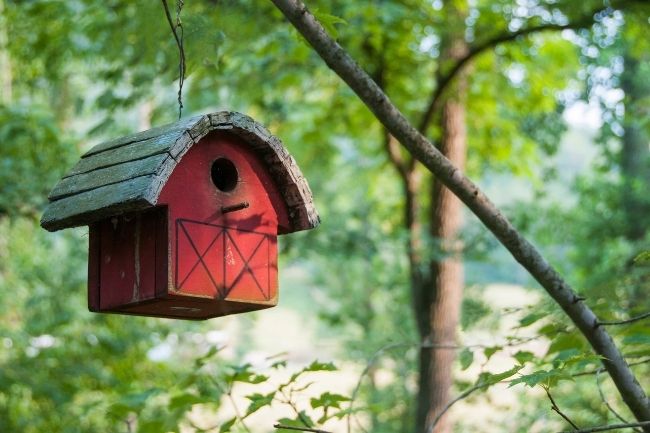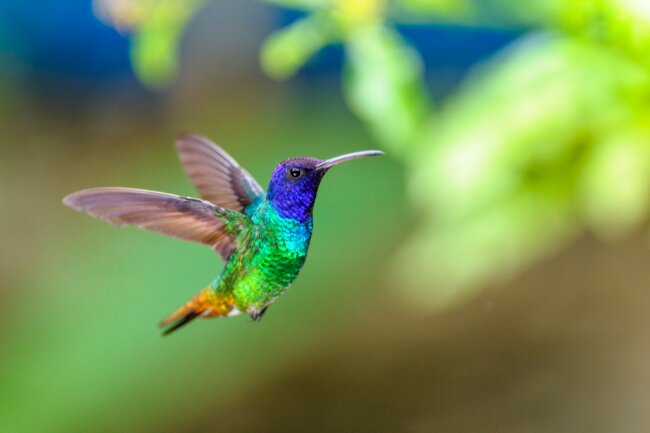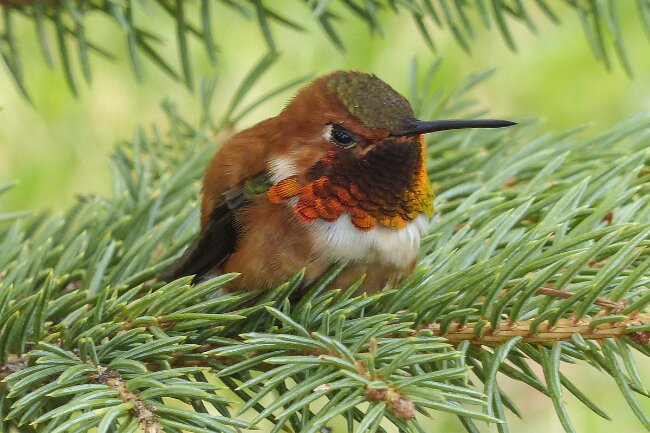Many birds benefit from the artificial birdhouses we create and erect. However, hummingbirds do not use these birdhouses, for a variety of reasons. Instead, natural nesting sites are preferred.
Contents
Why do birds use birdhouses?

There are a number of different birdhouse designs that are commonly used by humans to create nesting sites for wild birds. The most famous is a wooden box with an angled roof, which has a small round hole in the side.
The species that use these types of nests are usually cavity nesters. This means they naturally nest in cavities within trees or rock faces. Today many natural cavities have been lost, particularly through the felling of dead, damaged or older trees, for safety reasons, to harvest wood or to clear areas for development.
| Hummingbird Species | Preferred Nesting Habit |
|---|---|
| Ruby-throated | Trees, shrubs, and vegetation near water sources |
| Anna’s | Trees, shrubs, and man-made structures |
| Rufous | Trees, shrubs, and hanging planters |
| Allen’s | Trees, shrubs, and gardens with nectar-rich flowers |
| Costa’s | Desert scrub habitats with agave and cholla cacti |
The loss of suitable cavities results in fewer successful nests, meaning there are fewer young birds. This has a serious impact on the number of birds within a population.
Using different sizes or styles of birdhouses can attract different species, from barn owls to robins to swallows. For those looking to attract hummingbirds, however, things aren’t quite that simple.
Also read: Hummingbirds During the Winter… Migration Explained
Do hummingbirds use birdhouses?

If you want to attract hummingbirds into your garden, one of the things you might consider doing is putting up birdhouses for them to nest in. However, as hummingbirds aren’t cavity nesters, they do not use birdhouses.
One of the reasons hummingbirds do not use cavities to nest in is their flying style. It is tricky for them to enter into an opening in the same way that many other bird species do, given their rapid wing movements.
Instead, hummingbirds create small cup nests in the forks of branches or twigs. These nests are beautifully constructed by the female hummingbird after she has mated with a male. To create them, she gathers up a variety of materials including moss, small twigs, bark and downy seed heads.
| Aspect | Description |
|---|---|
| Size | Small and compact design to accommodate the hummingbird’s size |
| Entrance Hole | 1/2 inch diameter to exclude larger birds and predators |
| Materials | Durable and weather-resistant materials like wood or plastic |
| Roof and Overhang | Provide protection from rain and direct sunlight |
| Perches | Unnecessary, as hummingbirds prefer to hover rather than perch |
| Nectar Container | Optional attachment to supplement natural nectar sources |
The most amazing part of the construction is her use of spider webs to weave all of these loose materials together. The end result is a small cup, sat delicately on the fork of the branch. The inside is soft and spongy, made of many of the more downy components, and perfect for keeping eggs and chicks comfortable and warm.
The exterior will be rougher, however, this can help with the camouflage of the nest, pieces of bark, moss and lichen, making it difficult to spot in the vegetation.
The final trick that the nest holds is that it is slightly stretchy. As the eggs hatch and the chicks grow, the spiderwebs holding it together allow it to expand to accommodate them. With such a fancy nest, it’s not surprising hummingbirds don’t want our artificial birdhouses.
How long the nest is used depends somewhat on the species. Some birds will use a nest only once and then abandon it, but many will use it for multiple broods over the summer. Others will revisit the nest every year, saving them from having to start again.
How to encourage hummingbirds to nest

While birdhouses are no good for hummingbirds, some homeowners try putting up bird platforms. These are more like little shelves a hummingbird can build its nest on. However, there’s no guarantee even then that a hummingbird will make its home there.
The best way to encourage hummingbirds into your garden is to create a hummingbird paradise for them. Here are some things that hummingbirds are looking for in a nesting site;
Also read: Hummingbird Feeders… Good or Bad? (Explained)
Lots of nesting locations
For a hummingbird, ideal nesting locations are trees and bushes. Many will prefer to nest up high, so more mature plants are best. More open plants can also be less appealing as the nest will be more exposed.
A food supply
While putting out a hummingbird feeder can be one way to offer food, planting a wide range of nectar-rich plants is even better. Having a wildlife-friendly planting scheme also helps supply hummingbirds with their other food needs; insects.
A spider-friendly garden
While spiders may not be our favourite wildlife to encounter, there are many bird species that rely on them, including our hummingbirds. There’s no need to bring spiders into your garden, simply don’t kill them when you find them, and leave their webs alone if possible. Also, avoid using harmful pesticides that may affect these species.
Somewhere quiet
While hummingbirds may be attracted by the presence of a feeder, an overly busy garden may put them off nesting. Attempt to position feeders away from potential nesting sites, and don’t have too many on the go during the nesting season.
Somewhere dark
Artificial light is disruptive to many bird species. Outside lighting in gardens, or even lights that stay on all night by doors, can be harmful to many forms of wildlife. Try to minimize any nighttime lighting and avoid lighting up trees and other potential nesting spots.
A home for a hummingbird
While we may want to think that we know best when it comes to providing for wildlife, the truth is that nature often provides a more vibrant home to our wild animals. Having nest boxes up for some bird species can be very enjoyable, but we still need to protect old and dead trees to provide natural nesting spots as well.
For hummingbirds, we simply can’t replace what they can find in the wild with our own handy work. But the good news is by creating a paradise for these tiny birds we’ll also be providing homes for all kinds of other animals too, which is no bad thing.

